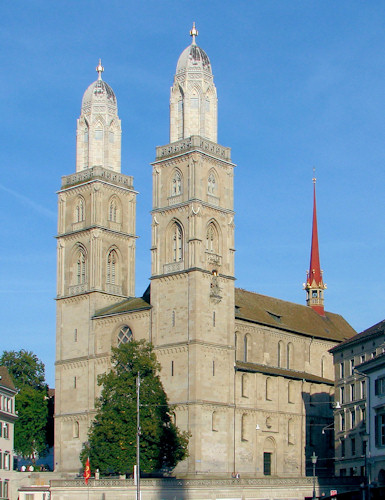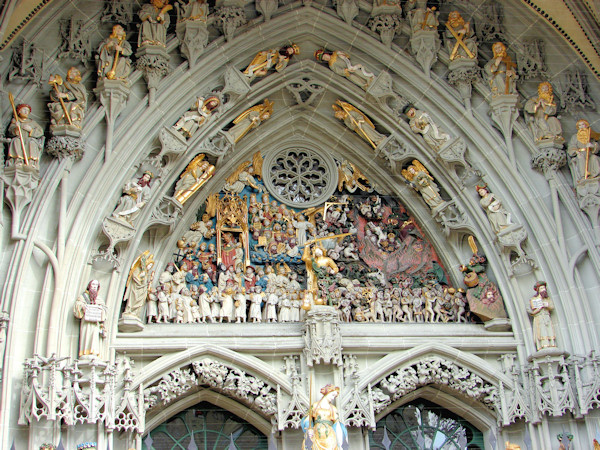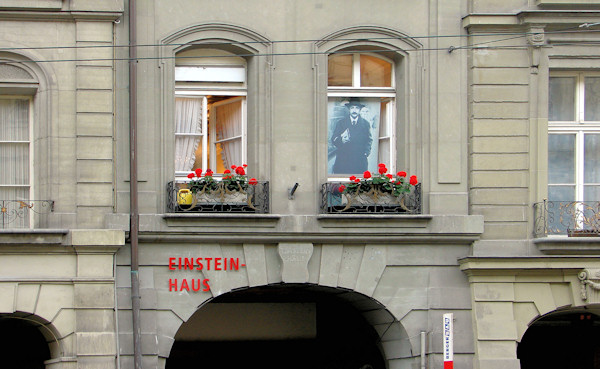Switzerland
Visited in September and October, 2010
| Zürich We used Zürich as a hub, with two major visits before and after the Adriatic cruise. | |
| The
rounded towers of Grossmünster in Zürich have become the symbols of the
city. Grossmünster is said to have been founded by Charlemagne,
but this building's construction started around 1100. The pastor
in charge, Huldrych Zwingli, was responsible for the Swiss
Reformation, severing ties with Rome in 1523. We were in Zürich a total of four times, twice in September and twice in October. This picture was taken on September 14, in beautiful summer-like weather. |  |
| Then
on October 7, the town was totally different. Fall had arrived,
and the trees had turned. We had clouds, not sun. It seemed
like a big change for 23 days absence. Photography was forbidden inside Grossmünster, but it has a fine collection of modern stained glass windows. It is hard to know what it was like in the 16th century after the iconoclasts stripped everything, even the organ. | |
| A Zürich sky.line. Zürich is a hilly city, but the construction,
particularly in the Old Town area here, is low rise.
Consequently, the skyline becomes dominated by church spires. I had problems trying to identify the church in the center. It is known as Predigerkirche, or the "Preacher's Church." It was originally built by the Dominicans, starting the the 12th century. Beyond it is Fraumünster, with St. Peter to the right and Grossmünster to the left. Thus, in this picture you can see the four major churches in Zürich. | |
| St. Peter Church is one of the big four in Zürich. While its origins are old, the existing structure is not that old. The current building was consecrated in 1706. The signal feature of St. Peter is its clock. At 28½ in diameter, it has the largest clock face of any church in Europe. | |
| The Limmat River runs through the center of Zürich, and here we see the west bank of the Limmat, punctuated by the tower of Fraumünster. Through the middle ages, Grossmünster and Fraumünster both competed and cooperated. The two are connected by a bridge. | |
| This is the east bank of the Limmat, again showing the spire of Predigerkirche. | |
| This
west bank view shows two important transportation items. Zürich
streetcars run all over, and frequently, too. At the right hand
edge of the picture, you can see a dock for the water taxi. It
runs less frequently, but it is more fun. Many of the buildings on this bank were originally built by Zürich's guilds. | |
| You can see that the river flows beneath the Rathaus (city hall). Immediately to the left is the Rathaus bridge. Please note the carousel on the bridge. | |
| We were struck by how closely the horses on this carousel resemble our carousel horse. We looked for common history, but these horses were carved in Italy, and ours is attributed to Frederick Heyn, from Germany. | |
| In a lot of ways, Zürich is a city of contradictions. Running off a very major street, Bahnhofstrasse, we have these little, almost country-like, lanes like Augustiner Gasse. This is really a very classy shopping street, with jewelry stores and restaurants. | |
| Just across from the train station, we have this tree shaded lane running along the Limmat River. This is a September picture, and it looked very different when we came back in October. | |
| Zürich is also filled with funky sculpture. The Zürich Angel may be an
extreme case. She hovers over the main hall of Zürich's main
train station. The proper name is "Protective Angel," and the artist was Niki de Saint Phalle. She was inspired by Gaudi, among others. | |
| And hills. Particularly on the east side of the Limmat, the hills are steep enough that a funicular is provided for students to travel between the river level and the universities above. | |
| At the top of the Polybahn, we find ETH. That clearly stands for Eidgenössische Technische Hochschule Zürich, or the Swiss Federal Institute of Technology. The school could be called the MIT of Europe. About two dozen Nobel laureates have been affiliated with ETH as either students or faculty. Albert Einstein was both. | |
| Luzern (or Lucerne) | |
| Luzern was a 45 minute train ride from Zürich. The Chapel Bridge is the most notable landmark. This
wooden bridge across the Reuss River is about 670 feet long, and made
of wood. Unfortunately, it burned in 1993 and had to be rebuilt.
A 20th century cigarette was more damaging than all the fighting since its construction in 1333. The Water Tower was a fortification, and it was built around 1300. | |
| The expensive rooms in our hotel, Hotel des Alpes, overlook the Chapel Bridge. The Reuss drains Lake Luzern, and there are five bridges in the space a little over a half mile. Two are very old. | |
| Looking at the south side of the Reuss from the last bridge, you can see a weir that effectively controls the water level in Lake Luzern. Out of sight, there is a hydroelectric plant driven by this water flow. | |
| The onion towers are on the Jesuit Church, which is important because Luzern remained Catholic after most of the balance of German-speaking Switzerland became protestant after 1520. Wars were fought among the cantons about this split. | |
| The interior of the Jesuit Church was High Baroque prior to 1750, when it was tamed down to merely Baroque. | |
| The
Rathaus (town hall) lies across the Reuss from the Jesuit Church.
We ate dinner at the Rathaus Restaurant, sitting beside the
river, not far from where you see the white boat. It seems like every tower in Switzerland has a clock. The Rathaus tower has several. | |
| Luzern's city walls remain on the hills north of the town. Looking down, you see a lot of red roofs, the Water Tower and the Town Hall tower represent high points in the town, but the mountains are impressive. | |
| Bern | |
| Bern is particularly notable for being the capital of Switzerland. The parliament building (Bundeshaus) was
completed in 1902, and it is made of limestone with a greenish cast.
It appears that the principal building of ETH in Zürich is made
of the same stone. I was standing on a bridge, more or less over the center of the Aare, to take this picture. | |
| While Zürich and Luzern both have lakes, Bern only has the River Aare, which makes a 180° loop around historic Bern. The apparent battlement on the left is the Cathedral Platform, mainly built in the 14th century. The platform is on the same level as most of the old city, but it is obvious that there is a lower city near river level. In fact, there is at least one public elevator that connects the upper and lower parts of the city. | |
| This tower formed a gate in the original 1250 city walls. The clock has a conventional dial about 6 feet about the top of this picture, but this calendar and zodiac indicator has a performance every hour. This is known as the Zytglogge. | |
| Construction of the Berner Münster was started in 1421, and its 100 meter tall bell tower was completed in 1893. However, it appeared to be under restoration when we were there. The Bern Cathedral door is a remarkable example of Late Gothic sculpture, and even more remarkable for having escaped the iconoclasm that seized Protestant Switzerland around 1530. The array of sculptures represents the Last Judgment, with Archangel Michael in the center, with the righteous on the left and the sinners, stripped naked, on the right. |  |
| I thought all this action was worth a close-up! | |
| One of the sons of Bern is Paul Klee. He was born just outside Bern, and had his secondary education here, but spent about 25 years of his career in Germany, finally returning to Switzerland in 1933. The Paul Klee Center, designed by Renzo Piano, opened in 2005, and it houses about 40% of all of Klee's art. | |
| Albert
Einstein is also claimed by Bern. He and his first wife rented
this second-floor apartment from 1901 to 1909, while Albert was
employed at the Swiss Patent Office. During 1905, Einstein published
several papers describing his theory of special relativity, products of
his nights and weekends walking in the country. Finally, in 1909, he was offered a position at ETH. It took a long time because Albert did not impress ETH as a student. |  |
| Lausanne | |
| Lausanne is in the French speaking part of Switzerland. It is also a city of steep hills. The part of the city fronting on Lake Geneva (north shore) is particularly elegant, and that is where the home of the International Olympic Committee is located, about a half mile to the right of this site. The picture shows the Hotel Beau Rivage Palace, probably the best in Lausanne; certainly the most expensive. (Not where we stayed.) | |
| The Lausanne Cathedral is a Lutheran church, even though this is the French part of Switzerland. It is located on a very high hill, so it towers above the rest of Lausanne. The old parts of Lausanne seem to be relatively integrated into the modern town. | |
| This
is the pipe loft in the Lausanne Cathedral, notable partly because the
organ was built by Fisk, a Boston based company. Integrating 7000
pipes into a 12th century Gothic cathedral was a challenge.
The largest ranks go up to 32 feet. The cathedral is the largest in Switzerland, and when we went to the concert here, it seemed pretty empty. That didn't detract at all from a fine concert. | |
| Getting to or from the cathedral on foot involves navigating the Escalier du Marche. The streets below a pretty steep, too. | |
| Aboard the Glacier Express | |
| We
caught the Glacier Expresss at Visp, so we missed the heights of
Zermatt. Frequent views were verdant valleys with streams and
villages. Photography was tough because of windows, motion and tunnels. Lots of tunnels. | |
| Sometimes the views were lakes, like this one. | |
| This is the point where the Rhine River begins. This is the junction of the Anterior Rhine and the Posterior Rhine. From here the Rhine flows northward, passing through Lake Constance on its way to Germany. | |
| Chur | |
| Archeology shows that Chur was occupied before 3500 BC, but most of the historic Old Town dates to the 12th or 13th century. Actually, Chur is not verywell documented. It is a hub for the Glacier Express and the Bernina Express, and its Old Town is a pedestrian area. | |
| One of two major churches in Chur is the Gothic St. Martins. | |
| Wandering the Old Town in Chur. | |
| Lugano | |
| Lake
Lugano is a fjord-like lake that is shared between Switzerland and
Italy. This proximity has been important to both countries. Part of the proximity effect is Lugano's use of Italian, not French or German. | |
| Gabbani has multiple shops in Via Pessina. I thought the salami shop caught the local color better than the wine shop. | |
| Built in 1349, the Chiesa San Rocco got its Baroque interior in 1723. Actually, from the outside, this is a dull toad of a church, but the interior is dazzling. This is not a Lutheran church! | |
| Piazza della Riforma is dominated by the 1844 city hall. It is said that, when the Italians were plotting to unify the country, and when they were plotting to make it a republic, this was the safe place to meet. | |
| One of Igor Mitoraj's "Eros Bound" series of sculptures. This one is in Piazza Independenzia, but it is but one example of a wide variety contemporary public art in Lugano. | |
| Bernina Express | |
| When you catch the Bernina Express from Lugano, the first few hours are by bus, driving along the north shore of Lake Lugano, and then along the north shore of Lake Como. The lake front roads are narrow and twisty, so the bus has the loudest horn I have heard, apart from trains and cruise ships. | |
| In Tirana, Italy, we catch the rail part of the Bernina Express. You can see the panorama windows. The head is on the snack trolley, which was a far cry from the full service lunch on the Glacier Express. | |
| The Bernina Express goes higher, and on our trip it had more glaciers, than the Glacier Express. | |
| I actually captured the name of this village, Bergün/Bravuogn. The first part is German, but the last part is in Romansh, one more of the Swiss languages. | |
| The trees along this stream are a mixture of pines and larches. The larches have needles like pines, but they are deciduous. On the 9th of October, they were a brilliant yellow. | |
| As we approached Chur, we approached sunset. Mountains punctuated by a church. | |
| Return Home | |